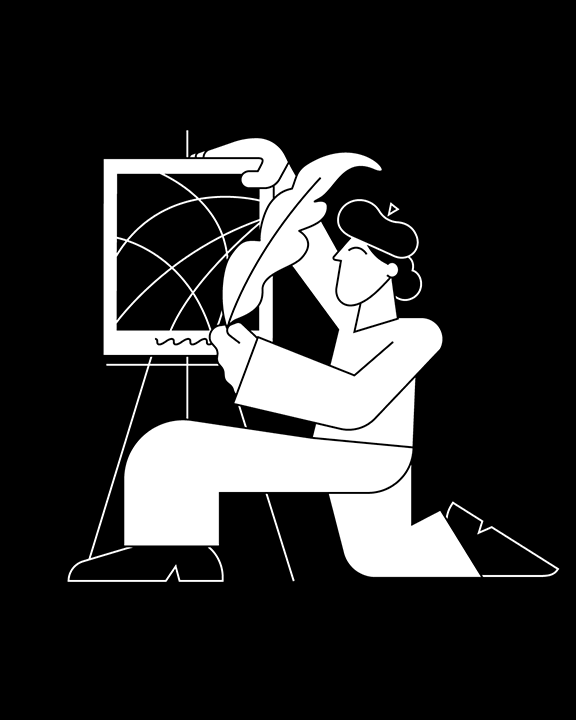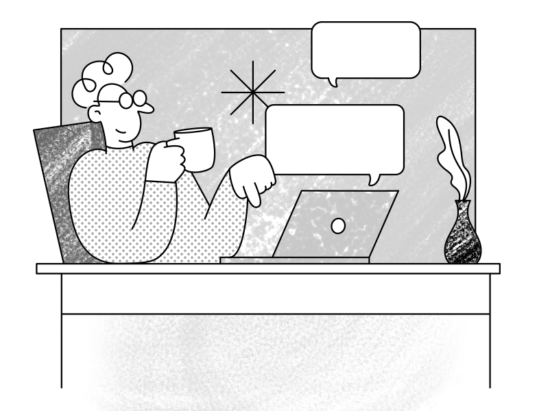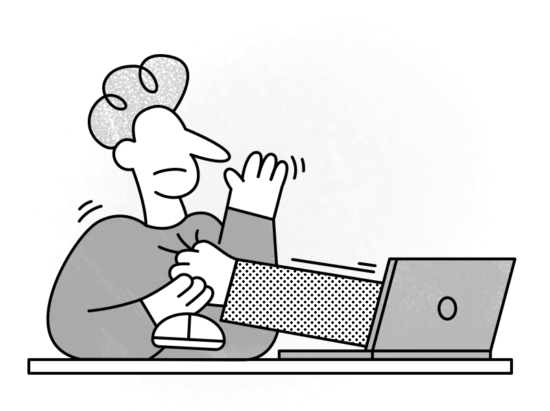Let’s talk about writing a project description.
As a (freelance) UX or graphic designer, illustrator, artist, you have one goal in mind: to get more gigs and clients.
That’s why you decided to create profiles on Dribbble and Behance. That’s why you started posting your magnificent work on Instagram. You hoped that clients would scroll through this platform and find your profile.
Being an overachiever (there’s no shame in that!), you also decided to make an online portfolio. You know, just in case recruiters are interested in seeing all your work in one place. You’ve worked on the design. Also, you found the right balance between the website style you like and the one clients find visually attractive. And you succeeded 一 you are satisfied with how the design turned out, and it will almost certainly knock recruiters of their feet.
Now, it’s time to focus on the content of your portfolio website 一 the About Page, your blog posts, Contact Page, etc. All of the mentioned pages are crucial for any online portfolio. However, you have to admit that the Projects page is an essential part of an online portfolio.
Yes, a Projects page is there to inform potential clients about the projects you have done, the style you used, how proactive and productive you are, whether you are a team player or not, how communicative you are, etc. Honestly, a Projects page can even tell more about you than the actual About page. Hence why we would advise you to focus on perfecting your project design and descriptions.
If writing isn’t your strong suit, and you remember hating writing essays way back in college, you’ll probably find writing a project description easier said than done. No worries 一 that’s why we have decided to write down a few tips that can help you create project copies clients would find intriguing, and amusing.
So, if you are in the dark when it comes to writing a text that explains the projects you’ve completed, here are some tips that can help you:
First, think about the Projects page
Before we move onto giving you tips on writing a project description, we wanted to mention a few tips that will help you choose the right projects for the page clients won’t minding reading about.
Here are those tips:
- It’s way better to list several, smaller projects than one huge. Also, don’t go overboard with listing the projects 一 up to 10 of them is more than enough.
- Include recent projects you’ve completed. Be sure to remember that clients don’t have the time to browse through the projects you did 10 years ago. They are not interested in how your style evolved! They want to see your current design style, and how well you adjusted to clients’ needs. The only exception to this rule is if you have an old project you are REALLY proud of.
- If you want to show a bit about your background, you can include your first project on the About page. You can mention your age and the idea behind it. We bet potential clients would find it adorable!
- Define featured images of your projects. Some online portfolios have the same cover photos placed on each project; some of them don’t. We’ll leave it up to you to decide what you want to do with these images.
- Be sure to separate your projects into categories, so clients don’t have trouble finding the ones that are beneficial for them. For example, if you have done several projects for different industries (two projects for Nike and Puma, one for Pixar and Disney, three for tech startups), you can separate the projects according to the industry they belong in.
Now that you are familiar with the tips that can help you create a Projects page, it’s time to get to writing a project description. Prepare yourself; it will be a bumpy ride.
Tip #1 一 Know for whom you are writing a project description
To be able to write proper project descriptions, you need to know for whom you are writing them. Making potential clients’ profiles will help you define the tone and voice you’ll be using when writing a project description.
First, let’s cover the tone.
The tone of your project copy adjusts to the clients you would like to partner up with. For example, if you are looking to partner up with one of the prestigious American colleges, to design a college website, or trying to get a job at The Hartford Courant (one of the oldest American news companies), you probably won’t be writing a project description something along the line “It was an interesting gig, I enjoyed hustling with these guys”. No slang allowed!
Now, the voice.
The voice of your project descriptions is more about the technical part of writing. For example, when writing them, you’ll try to provide as much useful information about the project as you can. Just make sure you don’t bore recruiters with a 3,000-word text. Your writing style should be informative, and the text should be perfectly clear, and grammatically correct.
Tip #2 一 Mention clients’ names, for sure
No matter if you have worked for a tech startup no one has ever heard or got hired by Apple, you need to mention clients’ names. Naturally, the more famous the clients are, the more recruiters will respect you and your work, especially if you were included in the project they are fans of.
When writing a project description and mentioning a client, we would suggest you write 2-3 sentences about the client, not clients’ requests, nor needs. If the client is not so well-known, you can explain what the company does and why they needed you to step in.
Tip #3 一 Explain the goals of every project
You already know that including stunning visuals of your work is a must. Those visuals can attract recruiters’ attention. However, if you want them to actually read what you have to say and stay on the Projects page, you need to give those visuals a context. As they say, content is king; but context is queen.
That’s why we would advise you to write goals of projects and mention these at the beginning of the text. Mention what clients wanted to accomplish by hiring you to complete the project. You can mention some guidelines they provided.
Tip #4 一 Explain your role, project guidelines, and struggles
What was your role in each of the projects? Did you manage a team of designers? Did you illustrate the billboard? Or, perhaps, made a book cover? Whatever the case may be, when writing a project description, you need to mention WHY a client hired you specifically, and what your role was.
When it comes to mentioning project guidelines you have were given, all we can say is: feel free to share as many details as you can, that won’t compromise the clients or bore the recruiters when they are reading them.
If you have partnered up with more than, let’s say, 2-3 companies, than you know that there’s not a project in the world that can go all the way smoothly. It’s natural to go through struggles and have a bit of trouble completing the project, no matter how much experience you have. You’re only human. You too can make a mistake!
Now, you probably wonder whether you should write about these struggles. We say: go for it! Potential clients love seeing and meeting someone who is honest and has no problem admitting he’s not perfect.
Just like you would mention what inspired you to create the design, tricks you’ve used to create it, you can mention struggles. However, don’t focus only on the troubles you went through 一 instead of focusing on the problem, switch to writing about the solution you’ve come up with. If you are not sure what we mean when we say the solution should be the center of attention, here’s an example to help you:
Don’t write: [Client name] team wasn’t satisfied with the result, so I needed to start over. The Art Director mentioned that my design was uninspiring, dull, …
Do write: After careful consideration by the [client’s name] team, there were some changes made in the design. The Art Director mentioned that the design didn’t speak to the right target audience, so I made three new solutions. The first one was a…
Get it now?
Tip #5 一 Mention project teammates (if there were any)
Mentioning people that were included in the projects is A MUST. If you think about it, It would be rude not to! However, as it usually goes, there’s an exception to every rule.
If you participated in a project alongside 5 people, feel free to name them all. However, if you designed a book cover, and over 30 people participated in the project, you don’t have to bother naming them all. Just mention who the client was and how many people were included in the project.
Are you ready to get to writing a project description?
Keep those fingers busy and start typing project descriptions! Before you do, be sure to, once again, go through the tips we mentioned, and we are sure you’ll do it in an hour, hour and a half tops!
Good luck, and may your portfolio site find a way to clients’ hearts!



